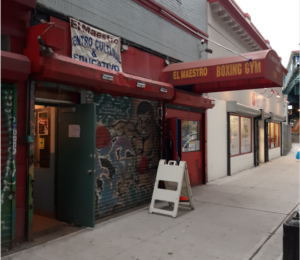
If you walk into El Maestro Boxing Gym at 5 p.m. on a Monday, you might find the gym full of young men, battering away at the bags and shuffling around the ring to the metronome of the round-timer.
Come in on the right Saturday night though, and you might find that instead of fighters shadow-boxing inside the ring, there’s a bomba band, or a fiery patriotic Puerto Rican poetry reading.
“Boxing is not enough,” gym founder Fernando Laspina said. Boxers can end up broke and brain damaged, Laspina said, and that’s why he designed El Maestro not just as a gym where neighborhood kids could learn to fight, but as a place where they could connect to Puerto Rican culture and history.
But after 16 years, Laspina’s community center is now under threat. His landlord has put the squat two-story building that houses El Maestro up for sale. Laspina has lost locations and been forced to downsize before, he said, but yet another move could be disruptive to what he’s managed to build at 1300 Southern Boulevard.
Akmicar Torres, 33, whose son Joseph trains at the gym, said it would be unthinkable to lose El Maestro. When he first walked into the gym to sign his son up for boxing classes, he was struck by the huge mural on one of the walls. It depicts a mix of Puerto Rican nationalist heroes and scenes from Taino folklore.
“It was like I was looking at a history book from my third grade in Puerto Rico,” Torres said. He described standing in front of the wall and explaining to his son Joseph, then 10-years-old, what their connection to this history was.
For many in the Puerto Rican community in this corner of the Bronx, El Maestro is a little piece of the old country.
“There’s no other place in New York that feels like home,” said Akmicar. “When I feel homesick, I go to El Maestro.” Four years after signing up Joseph, now 14, he’s a New York Junior Olympic Champion. His boxing lessons, Torres explained, take place entirely in Spanish.
Laspina’s path hasn’t been a straight one. A “jibaro” from the mountains of Puerto Rico, he moved to the Bronx at fifteen and quickly became a target for schoolyard bullying. He joined The Savage Skulls, a notorious black and Puerto Rican street gang, for protection. Within a few years, he’d risen to the rank of regional leader in the South Bronx. Fighting quickly became a part of his life. “Everyone always said I was good with my hands,” he chuckled.
But a two-year stint in prison for extortion made him rethink his priorities. He resolved to change. Prison proved to be a crash course in community organization, as he and other Spanish-speaking inmates had to band together and use their collective voices to, among other things, demand a bi-lingual chaplain.
Once out, he’d channeled the skills he’d learned as a prison-yard organizer into a career in grassroots community activism and outreach, helping to lead a campaign to keep Puerto Rican-founded Hostos Community College open. He enrolled in college, eventually earning a masters degree from Buffalo State University in Latin Studies. More than 40 years later, Laspina’s ties to his community go deep. He runs El Maestro and works as an extracurricular coordinator for the New York City Housing Authority.
Rising rent prices have caused the gym to have to move before: they’ve had four locations in the past 16 years. But now, the possible sale of the building, coupled with the discussion of zoning changes along Morrisania’s Southern Boulevard has many community members worried about what this might mean for El Maestro.
Yet another move could force them into a smaller space, less easily accessible by train than the current location, which is just down the block from the 2 and 5 stop at Freeman Ave. In turn, this could shrink the programs the gym is able to offer, and take away a critical linchpin in the cultural landscape of the neighborhood. “This gym keeps kids off the street and out of gangs, people come here who have messed up their lives and are trying to straighten out,” said 16-year-old boxer Firdaus Abdulai. “People take this place for granted, but it would be terrible if the gym got sold.”
Fernando doesn’t seem worried though. The Bronx has changed a lot in the years since the gym was founded, and they have always managed to survive, and if that means finding another location, so be it. Instead of dwelling on the potential sale of the property, he’s thinking about ways to grow. He’d love to launch a tutoring program for the kids who come to the gym. “That’s the dream, to have a space with computers where the kids could come and do homework,” he said. For now though, he’s happy to listen to the thud of gloves against the heavy bag.

